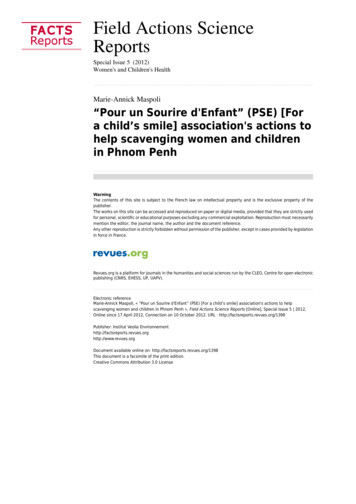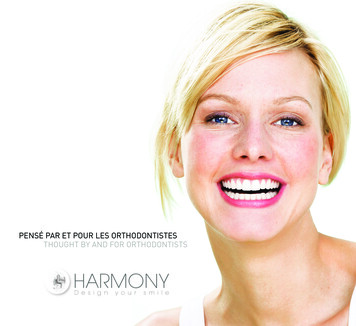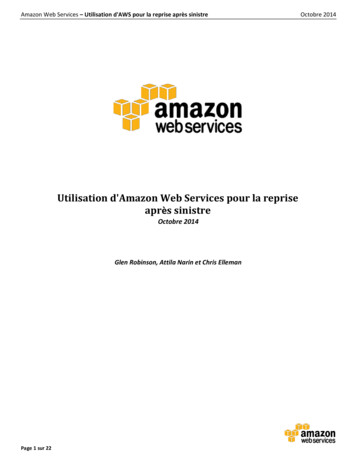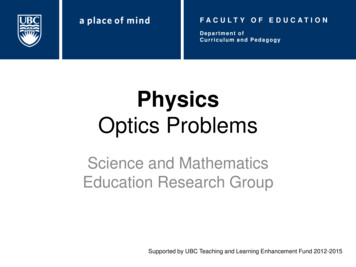
Transcription
Field Actions ScienceReportsSpecial Issue 5 (2012)Women's and Children's Health.Marie-Annick Maspoli“Pour un Sourire d'Enfant” (PSE) [Fora child’s smile] association's actions tohelp scavenging women and childrenin Phnom Penh.WarningThe contents of this site is subject to the French law on intellectual property and is the exclusive property of thepublisher.The works on this site can be accessed and reproduced on paper or digital media, provided that they are strictly usedfor personal, scientific or educational purposes excluding any commercial exploitation. Reproduction must necessarilymention the editor, the journal name, the author and the document reference.Any other reproduction is strictly forbidden without permission of the publisher, except in cases provided by legislationin force in France.Revues.org is a platform for journals in the humanites and social sciences run by the CLEO, Centre for open electronicpublishing (CNRS, EHESS, UP, UAPV).Electronic referenceMarie-Annick Maspoli, « “Pour un Sourire d'Enfant” (PSE) [For a child’s smile] association's actions to helpscavenging women and children in Phnom Penh », Field Actions Science Reports [Online], Special Issue 5 2012,Online since 17 April 2012, Connection on 10 October 2012. URL : http://factsreports.revues.org/1398Publisher: Institut Veolia www.revues.orgDocument available online on: http://factsreports.revues.org/1398This document is a facsimile of the print edition.Creative Commons Attribution 3.0 License
Author(s) 2012. This work is distributed underthe Creative Commons Attribution 3.0 ed 17 April 2012“Pour un Sourire d’Enfant” (PSE) [For a child’s smile]association’s actions to help scavenging womenand children in Phnom PenhMarie-Annick MaspoliStaff Pediatrician, Centre Hospitalier de Versailles, Versailles, France, Website: www.pse.asso.frAbstract. Founded 15 years ago, the association “Pour un Sourire d’Enfant” (PSE) [For a Child’s Smile] isa private initiative with the primary objective of educating scavenging children in Phnom Penh to enable themto find a place in society and live in dignity. In pursuing this goal, PSE adapts its actions to meet needs as theyarise and thus has considerable influence on the health of mothers and children.To give these children access to education and quality professional training, PSE’s first task was to feed themand provide healthcare. Education and training in health issues, the medical monitoring of the children andtheir mothers, as well as the residential care of the most severe cases, today accounts for a large part of the association’s administrative activities. It has of course been necessary to build more than just classrooms: sa nitary facilities, dispensaries, childcare centers, etc, were also necessary. In addition, in view of the country’shistorical context, the combat against domestic violence is necessarily given serious attention. The precariousbalance thus obtained is consolidated by paying the mothers to compensate for the children stopping work.Step by step, PSE is making progress by taking into account the Khmer culture, working in collaboration withother solutions locally, and encouraging Cambodians themselves to become involved. The association, work ing to improve the physical and mental health of the children and their mothers, is recognized by Cambodianbusinesses and authorities.Keywords. Poverty, healthcare, children, women’s health, Cambodia, education.1IntroductionCertain events in a country’s history have long term repercus sions: an example being the terrible Khmer Rouge genocidewhich, 35 years afterwards, has left a whole section ofthe Cambodian population totally disrupted. This is whatChristian and Marie-France des Pallières discoveredin1995 during a mission to Cambodia for another NGO.Considering what they saw to be unbearable – children scav enging through garbage but also being mistreated, beaten,abused, raped or sold by their own parents –, they decided tochange their lives, setting themselves up in Phnom Penh torestore dignity to the children, first using their own resourcesand then appealing to friends in a network that has neverceased to grow. PSE began very modestly in 1996. Todayover 6500 children benefit from the different programs, un der the supervision of 450 employees, all Khmer, and over2000 young people have already completed our programs.Armed with a diploma, employed in worthwhile jobs, theyhave been definitively emerged from poverty.I joined the association’s administrative board and tookon the responsibility of liaison officer for the medical pro grams in 1999. My first contact with the children was ashock: I had already seen scavenging children in othercountries, but these children had something terrifying intheir gaze, they looked too serious, worried, as though theyhad aged prematurely.PSE’s primary objective is not medical: its goal is to provide an education for the children, in its center or inpublic schools, and above all to provide job training, in itsProfessional Training Center or in one of the city’s schoolsor universities, so that when the children reach adulthood,they can lead their lives in dignity. However, this projectcannot be conducted without paying particular attention tothe health of the children and their families.2General and geographical backgroundPSE addresses the needs of scavenging children of the cityof Phnom Penh. Today, Cambodia still has many problems recovering from underdevelopment: the gap is widening between those who are becoming more affluent and thosewho are becoming poorer, given that the inflation rate is animportant criterion Finally, the scavenging children arechased away from the center of the city by the real estate development and the renovation of whole districts.
M.-A. Maspoli: “Pour un Sourire d’Enfant” (PSE) [For a child’s smile]Figure 1. Healthcare at one of the paillotes.The poor of Cambodia suffer more from malnutritionthan undernutrition (rice provides calories but not the pro teins essential for good health). The field action thus began in1996 with the concept of the “hut in the slum” (the Paillotte),where a well-balanced daily meal is distributed to small chil dren and pregnant women. Since then, we provide all mealsto children at the center and we distribute sandwiches tothose who attend city schools; 9000 meals or sandwiches are distributed every day. Since 1997, we began the educationprograms for the children, and the other programs were thenadded sequentially through the years, depending on theproblems that we encountered.3Methodological issuesAt least once a year, our social workers evaluate the level ofpoverty of the families of the children whom we accept. Themost impoverished families earn less than US 0.5 per dayper person, and the upper limit for acceptance to our pro gram is US 2.0 per day per person. In between the twovalues, PSE sometimes requests a small financial contribu tion from the families for the healthcare, education and/ormeals of the children.Some families may improve their standard of living whenthe oldest children begin to work or when the parents find bet ter work thanks to microcredit loans provided by other NGOs.We would have aggravated the health problems of themothers if we had simply hosted their children in our Centeror at school: the meager sums obtained from the resale ofgarbage is indispensable for the survival of many families.From the beginning, we have therefore introduced a systemof rice redistribution to the families in order to compensatefor the income lost when the children stop working. This system requires 14 tons of rice every week!We identify problems through regular discourse with thechildren and, if possible, with their parents. When a problemis defined, PSE determines whether a local solution is possi ble. If this is the case, we accompany the families towards theright people. If the existing solution is not very satisfactory,then PSE strives to improve it. Thus, the schools in the poor2Figure 2. A newborn baby being welcomed to the center.neighborhoods would host the students only 1/3 of their time,in order to educate three separate groups of students in thesame grade, but the rest of the time, the children would con tinue to scavenge. PSE therefore constructed supplementaryschool rooms, and reached an agreement with the Ministry ofYouth to hire more teachers. The children are now in schoolhalf of the time, and we occupy them the rest of the daythrough personalized education activities.When there are in fact no local solutions, then PSE imple ments a program whose entire staff is Cambodian: a programdirector, assisted by an assistant for each branch of the activ ity (health, social work, pedagogy, maintenance, finances,management, and human resources).Cambodia does not have a Social Security system.Despite the high costs of healthcare, at the “Paillotte” weoffer emergency health care, respiratory physiotherapy sessions ( garbage produces many toxic fumes and the re sulting respiratory diseases are more rapidly cured withphysiotherapy), hygiene education, and HIV/AIDS infor mation. (Figure 1.) When a woman thinks she might be af fected, we propose an anonymous diagnostic test free ofcharge then we refer her if necessary to a health care facil ity. We have not succeeded in eliminating AIDS, but it is nolonger transmitted from the mother to her foetus.A midwife employed by PSE monitors pregnancies, en courages women to give birth at the dispensary (where thenewborn are vaccinated) and distributes delivery kits thatare “clean”, if not perfectly sterile, to those who cannot orField Actions Science Reports
M.-A. Maspoli: “Pour un Sourire d’Enfant” (PSE) [For a child’s smile]Figure 3. Vaccination at the school healthcare center.Figure 4. Informational meeting between a midwife and thevillage community.do not want to go to the dispensary. For several years nowwe no longer see any cases of neonatal tetanus. (Figure 2.)We pay a “breastfeeding bonus” to compensate for the lossof income to mothers who stop their scavenging activity inorder to breastfeed their babies for 6 months; in this waywe improve the nutrition of the mothers and the health ofthe babies, and we believe that this bond helps to preventfuture mistreatment.has been reached with a dental school to ensure systematicdental examinations. Outside of school hours, the medicalservice at the Center is open 24 hours, 7 days a week.Health care is provided by Khmer medical and paramedi cal teams, who were trained in Cambodia and work withWestern professional volunteers. This arrangement also al lows us to be respectful of traditional health care procedures(meditation, respiration, tigre balm, homeopathy, etc).We have investigated ways in which we could reduce do mestic violence. In fact, domestic violence causes more suf fering among the children than poverty. I will never forgetyoung Phoen who said, “scavenging through garbage, whenyou are poor, is normal (!!!); what is sad is when the parentshit their children so hard.” Why so much violence? The fa thers of the affected children were children themselves whenthe genocide was perpetrated in 1975; they lived throughtheir childhoods in a climate of terror, violence and denuncia tion. What they need to do now is try to forget, and alcohol isa good amnesiac, especially when you are poor.It was not up to us, the Westerners, to tell them what to do;Khmer culture does not tolerate criticism, which causes “lossof face”. We have organized theatre sessions, where the chil dren write the scripts and invite their parents. Unfortunately,frequently only the mothers come. (Figure 4.) Every week,the children have time for a “discussion about life”; they talkabout their projects, among which a recurrent theme is to starta family in which everyone gets along well together .Improving living conditions is an excellent means of com bating violence. The violence has not disappeared complete ly, but diminished considerably. We have distributed mobiletelephones so that we can be contacted in the event of anemergency; in just a few years, I have seen the number ofcalls drop from 5 or 6 per night to 2 or 3 per week. It still hap pens that a woman dies from her husband’s blows before theeyes of her powerless children. The children in greatest dan ger cannot return to their families in the evening and are ac commodated either at the Center or in foster families. We tryto avoid breaking all ties with the family and accompany thechildren when they visit their parents.4The tools of the programWe provide day care for small children so that their motherscan go to work, without leaving the children alone or entrust ing them to an older sister who is then obligated to give upher education. The children are cared for either in neighbor hood childcare centers, where they play stimulating games,or in a Feeding Center for the more fragile children (prema ture babies; malnourished, sick or disabled children) wherethey are closely monitored and led as necessary to appropri ate care facilities, both public and run by NGOs. This year,we have sent for surgery one baby with heart disease andanother with hydrocephalus.All children educated by PSE, in neighborhood schools orin remedial classes (for those who have missed out on morethan 4 years of education), benefit from at least one medicalcheck-up per year, vaccinations (the government has begunto organize mass vaccination campaigns but they do notreach the whole population) and any necessary health care.(Figure 3.) For this, we have at their disposal a dispensary inthe PSE Center, 3 nurses in the schools attended by a greatnumber of pupils, and 2 mobile nurses who go from oneschool to another. The other pupils, who are not directly sup ported by PSE because their parents are not extremely poor,may also receive emergency treatment, and thus 20,000 chil dren benefit each year from this program. The PSE doctorsand nurses visit classes regularly to give lessons on hygiene(cleanliness, dental hygiene, human relationships). PSE hasalso built toilet facilities in schools that lacked them andwells dug in the slums where the families live. An agreementwww.factsreports.org3
M.-A. Maspoli: “Pour un Sourire d’Enfant” (PSE) [For a child’s smile]5Political recognitionThe government does not provide any material assistance toPSE but acknowledges its usefulness and qualifications: Christian et Marie-France des Pallières were grantedCambodian citizenship, The queen has visited the PSE Center, The association’s professional training Center was renamed the PSE Institute, which gives our diplomasnational accreditation and equivalency with the diplo mas offered by the State, and allows instructors fromthe State to be trained in PSE classes, etc.As PSE is politically neutral, the national governmentdoes not resist in any way the association for its activities. Inthe long run, the government would like to take responsibil ity for the children’s education. Although this would not befeasible for many years, PSE would then refocus its activitieson the most vulnerable children: the orphans, the handi capped children, etc.We have already looked for a facility that could take care ofthe children with incapacitating handicaps or not able to learneven under the optimal conditions offered by the Center ofremedial classes. But we have not found a solution yet. So wecreated a special needs education section for children withserious learning disabilities and a special class for the mostseriously disabled children. This program is run by a physio therapist and a special needs teacher who went to France fortraining, since Cambodia does not have yet a special needseducation system. Our main worry is now to find a partneragency that could take over from us in caring for the childrenwho could not become independent due to disabilities, whenthey become old enough to leave the PSE facilities.6site. Each year, Christian and Marie-France des Pallièresspend 2 to 3 months travelling around France and Europeto present, with film footage, the current state of affairs. The annual budget of the PSE, including all of its programs, isabout 6,000,000 euros.8ConclusionsOur programs are beginning to rely increasingly onCambodian teams that are employed by PSE; and the activi ties carried out by Western teams are becoming more dis crete, even though none of them have been stopped, giventhat none can be replaced yet by local expertise.We do not possess any health indicators that allow us toevaluate our results objectively, but we base our conclu sions on our direct contact with the affected populations: itis clear that the physical and mental health of the children supported by PSE is improving. Our greatest joy is whenour “former” beneficiaries, more than 2.000 of whom haveformed an association, come back to tell us about their fam ilies and their jobs.Obstacles and problemsThe cost of living is increasing at an alarming rate as far asfood, health care, and the salaries of our 450 employees areconcerned. The number of children admitted to our programsover the past few years and now in professional training isincreasing rapidly, which in turn increases considerably thecost per assisted child. Finally, the buildings, which werebuilt ten years ago, are beginning to show their age.7Costs of the programHow did the goodwill of a simple couple develop over just afew years into such “a machine to eradicate poverty”? Well,thanks to a very dynamic network, mainly throughout Franceand Europe, that works to raise awareness about PSE’s ac tions. The funding is all private. Sponsorships are not indi vidualized for reasons of cost and fairness between children;and donations and legacies are from individuals, foundations,and corporations. Our donors are happy, since we take greatcare to inform them directly: a short 4-page newsletter is sentout every quarter from Cambodia and the administratorsmake regular visits to help advance the projects for whichthey are responsible in liaison with the management teams on4Field Actions Science Reports
Author(s) 2012. This work is distributed under the Creative Commons Attribution 3.0 License. ht











